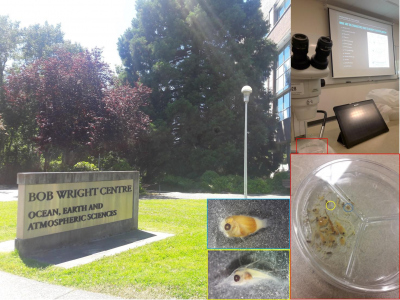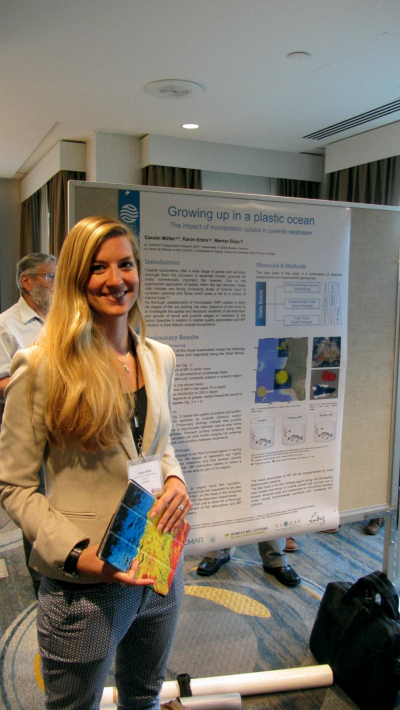Carolin Müller
Report of GLOMAR PhD student Carolin Müller about her participation in the 42nd Annual Larval Fish Conference and Larval Fish Identification Workshop in Victoria, Canada from 23 to 28 June 2018
For my PhD, which started in October 2017 at the Fisheries Biology Working Group of ZMT, I investigate the impact of microplastic on juvenile fish survival and growth in coastal ecosystems. With the support of GLOMAR, I was able to seize the opportunity to present my project already in the first year of research to renowned scientists from around the world in the 42nd Annual Larval Fish Conference in Canada during a poster session. Constituting an official subunit of the American Fisheries Society (AFS), the Early Life History Section is the only association of this kind addressing and representing an exhaustive field of research disciplines related to the early life history of fish. The annual Larval Fish Conference, which arose in 1977 from a series of freshwater-oriented symposia, nowadays promotes exchange not only between the more than 400 international members of the AFS, but also serves as an introduction of early-career scientists and students to the international research community. This objective is reflected by side-events organized along the conferences, such as mentoring sessions or workshops with students having priority to participate. This year’s conference was particularly relevant for me as one of the sessions explicitly covered emerging threats to early life stages of fish – among ocean acidification, increasing water temperatures and habitat degradation, microplastic pollution was identified one of the anthropogenic impacts affecting larval and juvenile fish growth and survival.
The conference started on the 23rd of July for around 30 other early-career scientists and myself with a 1-day larval identification workshop at the Bob Wright Centre for Ocean, Earth and Atmospheric Sciences at the University of Victoria, Canada. After learning about the key parameters in fish larvae identification (e.g. body shape, the number of myomeres, pigmentation patterns or spines) during a lecture, all participants received a vial with a number of different fish larvae to identify to family level. Backed by the expertise of our lecturers and a lot of help from the literature, we succeeded in identifying a variety of different fish families in our samples and all of us were all fascinated by the diversity found in ichthyoplankton samples.
The following Sunday, a 3-hour workshop on proposal writing was offered to the conference participants prior to the registration and opening reception in the evening. A lecture in combination with a group work and a Q&A session of panel members conveyed a lot of helpful information on how to improve the chances of your proposal being selected for funding and the event fostered the personal interaction with experienced scientists. During the following opening reception, many of the conference attendees met in the Harbour Room of the Delta Ocean Pointe Resort; this hotel was chosen as the venue for the entire conference.
With the official start of the 42nd Annual Larval Fish Conference on the 24th of July, the following four days of talks and the poster session on Monday evening were to provide a huge variety of research fields and insights on early life stages of fish for the approximately 100 participants. The talks as well as the posters were presented by both students and established scientists from around the world which again served as a perfect introduction of early-career researchers to the scientific world. Many of us students appreciated the welcoming atmosphere of the conference along with the highly constructive interaction with all the scientists and their genuine interest in our research projects.
On Wednesday evening, the AFS Early Life History Section awarded the best student presentation with the Sally Leonard Richardson Award as well as the best student poster with the John H.S. Blaxter Award. Receiving this year’s Blaxter Award for my poster, I feel extremely honoured and encouraged not only by the judges of the Early Life History Section but by all researchers who took their time to examine my poster, listen to my explanations and engage in a conversation about the relevance of my research.
My first international conference abroad was a great experience and a big success for me and I was encouraged to participate in following conferences of the AFS Early Life History Section. One of the next important steps for my scientific career will be to present my findings from the field and the lab in a talk – maybe the 43rd Annual Fish Larval Conference on Mallorca in May 2019 will offer the perfect opportunity for me again!
Altogether, I am very grateful for the chance to participate in this conference not only through the travel grant of GLOMAR but also through the conceptual support of Martin Lukas and his seminar on poster design which he self-initiatively shared with me prior to the conference.




